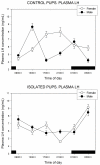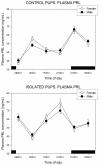Effect of rabbit doe-litter separation on 24-hour changes of luteinizing hormone, follicle stimulating hormone and prolactin release in female and male suckling pups
- PMID: 16188031
- PMCID: PMC1253533
- DOI: 10.1186/1477-7827-3-50
Effect of rabbit doe-litter separation on 24-hour changes of luteinizing hormone, follicle stimulating hormone and prolactin release in female and male suckling pups
Abstract
Background: The daily pattern of nursing of the rabbit pup by the doe is the most important event in the day for the newborn and is neatly anticipated by them. Such anticipation presumably needs a close correlation with changes in hormones that will allow the pups to develop an appropriate behavior. Although a number of circadian functions have been examined in newborn rabbits, there is no information on 24-h pattern of gonadotropin release or on possible sex-related differences in gonadotropin or prolactin (PRL) release of pups. This study examined the 24-h changes of plasma luteinizing hormone (LH), follicle stimulating hormone (FSH) and prolactin (PRL) in 11 days old suckling female and male rabbits left with the mother or after short-term (i.e., 48 h) doe-litter separation.
Methods: Animals were kept under controlled light-dark cycles (16 h-8 h; lights on at 08:00 h). On day 9 post partum, groups of 6-7 female or male rabbit pups were separated from their mothers starting at 6 different time intervals in the 24 h cycle. Pups were killed 48 h after separation. At each time interval groups of male or female pups that stayed with the mother were killed as controls. Plasma, LH, FSH and PRL levels were measured by specific radioimmunoassays.
Results: In pups kept with their mother plasma FSH and LH maxima occurred at the first and second part of the light phase (at 13:00 and 17:00-21:00 h, respectively) (females) or as two peaks for each of the hormones (at 13:00 and 01:00 h) (males). PRL release was similar in female and male rabbit pups kept with their mother, showing a 24-h pattern with two peaks, at 13:00 and 01:00 h, respectively. Mean 24-h values of gonadotropins and PRL did not differ between sexes. Isolation of pups for 48 h augmented circulating gonadotropin and PRL levels and distorted hormone 24-h pattern to a similar extent in both sexes.
Conclusion: Significant sex differences in 24-h changes in LH and FSH, but not in PRL, release occurred in rabbit pups kept with the doe. Separation of newborn pups from their mother augmented circulating gonadotropin and PRL levels and disrupted 24-h rhythmicity of gonadotropin and PRL release similarly in both sexes. The effect of pups' isolation can be attributed either to a modification of the circadian pacemaker or to a masking effect on some of its output overt rhythms.
Figures



Similar articles
-
Effect of litter separation on 24-hour rhythmicity of plasma prolactin, follicle-stimulating hormone and luteinizing hormone levels in lactating rabbit does.J Circadian Rhythms. 2005 Jun 2;3:9. doi: 10.1186/1740-3391-3-9. J Circadian Rhythms. 2005. PMID: 15932637 Free PMC article.
-
Circadian rhythms of prolactin secretion in neonatal female rabbits after acute separation from their mothers.Gen Comp Endocrinol. 2006 May 1;146(3):257-64. doi: 10.1016/j.ygcen.2005.11.021. Epub 2006 Jan 19. Gen Comp Endocrinol. 2006. PMID: 16426607
-
Release of luteinizing hormone and follicle-stimulating hormone from pituitaries of lactating rats by gonadotropin-releasing hormone and high potassium concentration.Endocrinology. 1985 May;116(5):1826-34. doi: 10.1210/endo-116-5-1826. Endocrinology. 1985. PMID: 2985363
-
The rabbit pup, a natural model of nursing-anticipatory activity.Eur J Neurosci. 2009 Nov;30(9):1697-706. doi: 10.1111/j.1460-9568.2009.06964.x. Epub 2009 Oct 26. Eur J Neurosci. 2009. PMID: 19863657 Free PMC article. Review.
-
Mothers and offspring: The rabbit as a model system in the study of mammalian maternal behavior and sibling interactions.Horm Behav. 2016 Jan;77:30-41. doi: 10.1016/j.yhbeh.2015.05.011. Epub 2015 Jun 7. Horm Behav. 2016. PMID: 26062431 Review.
Cited by
-
A mechanistic look at the effects of adversity early in life on cardiovascular disease risk during adulthood.Acta Physiol (Oxf). 2014 Feb;210(2):277-87. doi: 10.1111/apha.12189. Epub 2013 Dec 13. Acta Physiol (Oxf). 2014. PMID: 24330084 Free PMC article. Review.
-
Exploring the impact of chia seeds and matcha green tea on gene expression related to the puberty pathway in growing male New Zealand white rabbits.Trop Anim Health Prod. 2025 Apr 2;57(3):152. doi: 10.1007/s11250-025-04391-x. Trop Anim Health Prod. 2025. PMID: 40172761 Free PMC article.
References
-
- Jilge B. The ontogeny of circadian rhythms in the rabbit. J Biol Rhythms. 1993;8:247–260. - PubMed
-
- Alvarez MP, Cardinali DP, Jimenez V, Alvariño M, Esquifino AI. 24-Hour rhythm of plasma prolactin in female rabbit pups. Correlation with hypothalamic and adenohypophysial dopamine, serotonin, gamma-aminobutyric acid and taurine content. Animal Reprod Sci. - PubMed
Publication types
MeSH terms
Substances
LinkOut - more resources
Full Text Sources

